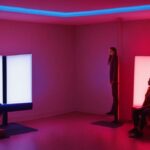Last Updated on 1 year by Francis
Bright light therapy is a form of treatment that involves exposure to high-intensity light for a prescribed amount of time each day. It is commonly used to treat seasonal affective disorder (SAD), a type of depression that typically occurs during the darker months of the year. Bright light therapy can also be used to alleviate symptoms of sleep disorders, jet lag, and other conditions related to circadian rhythm disruptions. In this therapy, individuals sit or work near a device that emits bright light, usually for 30 minutes to an hour per day. The light is specifically designed to mimic natural outdoor light, and it is believed to stimulate the brain’s production of serotonin, a neurotransmitter that helps regulate mood, sleep, and appetite.
Contents
Shedding Light on a Promising Treatment for Seasonal Affective Disorder
Understanding the Basics of Bright Light Therapy
Bright light therapy is a non-invasive treatment that involves exposure to bright artificial light to help regulate the body’s circadian rhythm. It is commonly used to treat seasonal affective disorder (SAD), a type of depression that occurs during the fall and winter months when there is less sunlight. The therapy involves sitting in front of a light therapy box that emits bright light, typically between 10,000 and 20,000 lux, for a set amount of time each day.
How Bright Light Therapy Works
The exact mechanism behind bright light therapy is not fully understood, but it is thought to help regulate the body’s production of melatonin and serotonin. Melatonin is a hormone that plays a role in regulating sleep, while serotonin is a neurotransmitter that affects mood. Exposure to bright light may help increase the production of serotonin and decrease the production of melatonin, which can help alleviate the symptoms of SAD.
The Benefits of Bright Light Therapy
Bright light therapy has been shown to be an effective treatment for SAD, with studies indicating that it can improve mood, increase energy levels, and regulate sleep patterns. In addition to SAD, bright light therapy has also been used to treat other conditions, such as non-seasonal depression and sleep disorders.
How to Use Bright Light Therapy
To use bright light therapy, you will need a light therapy box that emits bright light. These boxes can be purchased online or from medical supply stores. It is important to choose a box that emits the correct intensity of light, typically between 10,000 and 20,000 lux. The box should also have a built-in timer to ensure that you receive the correct amount of light exposure.
To use the therapy, sit in front of the light therapy box for a set amount of time each day, typically between 20 and 60 minutes. It is important to sit within a certain distance from the box, typically between 16 and 24 inches. The therapy should be used daily, preferably in the morning, for the duration of the fall and winter months.
Potential Side Effects of Bright Light Therapy
Bright light therapy is generally considered safe, but there are some potential side effects to be aware of. These can include:
- Eyestrain
- Headaches
- Nausea
- Irritability
- Difficulty sleeping
If you experience any of these side effects, it is important to speak with your healthcare provider. They may recommend adjusting the intensity of the light or the duration of the therapy.
FAQs – What is Bright Light Therapy?
What is bright light therapy?
Bright light therapy is a treatment that involves exposure to intense levels of light, typically in the morning, for the purpose of resetting your body’s natural biological clock. It is a way to treat sleep disorders or issues with seasonal depression by mimicking the natural light patterns of the sun. The therapy involves sitting in front of a lightbox, typically for anywhere from 20-60 minutes a day.
Who is bright light therapy recommended for?
Bright light therapy is recommended for individuals suffering from seasonal affective disorder (SAD), depression, jet lag, circadian rhythm disorders, insomnia, and bipolar disorder. Furthermore, it can be used to mitigate symptoms associated with Parkinson’s disease, dementia, and Alzheimer’s disease.
What are the benefits of bright light therapy?
The primary benefit of bright light therapy is to positively impact your circadian rhythm. Your circadian rhythm is responsible for regulating your body’s natural sleep-wake cycle, which can become imbalanced if you experience too much or too little light exposure. Bright light therapy has the ability to reset your biological clock, which may help regulate your sleep, enhance your mood, and alleviate various symptoms of depression.
What are the side effects of bright light therapy?
Most individuals who try bright light therapy don’t experience any negative side effects. However, a few individuals have reported experiencing headaches, eye strain, nausea, and agitation. Additionally, people who experience bipolar disorder with mania should speak with a healthcare provider prior to attempting treatment via bright light therapy.
How is bright light therapy administered?
Bright light therapy typically involves sitting in front of a lightbox for 20-60 minutes each day. The brightness of the lightbox should have at least 10,000 lux of illumination, which is about 20 times brighter than typical indoor lighting. You should sit with the lightbox approximately 16-24 inches away from your face without staring directly into the light for the best effect. Some people find that spreading the light exposure over the course of the day mitigates issues with irritability or other side effects.



.jpg)



